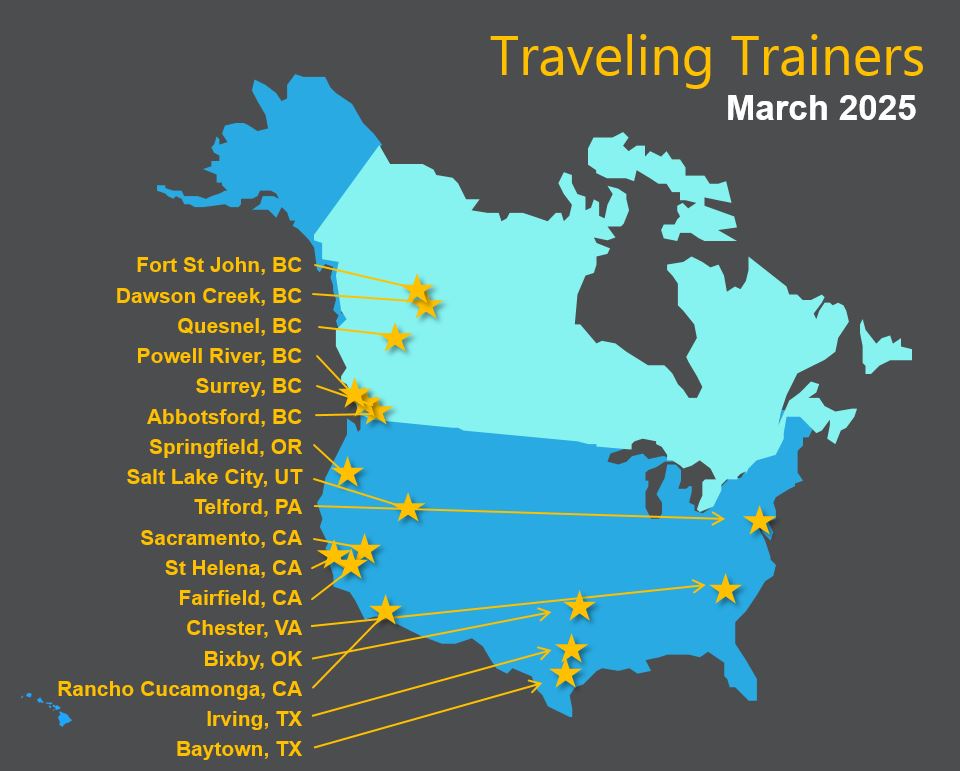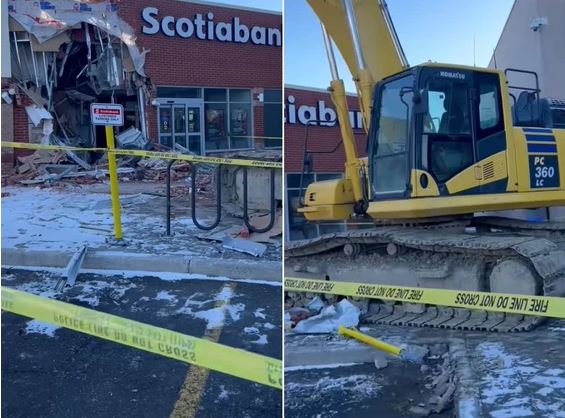
The IVES Update Newsletter is a highly informative monthly e-newsletter. It contains up-to-date industry information, regulatory updates, stories from the field, upcoming program dates, What’s Wrong With This? photos, incident reports, our interactive “Ask Bob” question and answer column, new product details and much more.
Whether you're interested in forklifts, mobile elevating work platforms, loaders or excavators – we’ve got you covered. Want to receive it directly to your inbox? Sign up for our IVES Update e-Newsletter!
Year:

When I speak with safety officers, risk managers, safety professionals, and other professionals charged with training and maintaining safety at their given facility or organization they express a common concern, maintaining and in some cases building a safety culture can be difficult and problematic. “Safety is priority number one.” It is often used as a catch phrase. There is a common misconception that new employees are the “safest employees.”
According to a Gallup report, a new employee takes around twelve months to become fully productive in their new role. Twelve months to three years is in my opinion and, experience is the “sweet spot” for safety. These employees focus on working safely and productively. Once we get beyond the sweet spot due to complacency and separation from safety training the number of workplace accidents begins to increase. If safety training is your area of responsibility, you want to stave off the possible increase in workplace accidents.
Steps to get you started
A consistent safety training program can fill the new employees’ knowledge gaps and refresh older employees focus on safety. Daily safety talks work well on construction sites and manufacturing facilities, but they may not be as effective in warehouses or business settings. The proximity to injury is immediate on construction sites, manufacturing, and public safety organizations. In a business environment the chance of being injured while working is significantly reduced.
Construction workers use tools with pointed edges, tools that can cause blunt force injuries, power tools, and may be on ladders or scaffolding greater than six feet above the ground. Even though a business environment has a reduced chance of injury compared to the other professions I mentioned. Safety should still be a priority. Regular training and safety education are essential.
The first step in building a safety culture at your facility is to develop and establish a comprehensive safety training program. Developing a comprehensive program requires an Initial Needs Assessment (INA). Review previous workplace incidents and accidents. Do research to analyze past safety incidents, identify hazards that have taken place more than one or two times and identify training gaps that were present at the time the incidents and or accidents occurred.
Conduct regular inspections of the facility and identify potential hazards such as: slips-trips-and falls, dangers related to machinery being used and in operation at your facility, electrical problems that can harm employees and patrons, chemical/haz-mat exposure. Conduct a detailed review of Safety Data Sheets (SDS). Review the safety information related to chemicals used in the workplace. If needed seek out expert advice to identify and help prioritize hazards.
After collecting data applicable to your facility, it is time to set training objectives for staff and employees. Establish what employees should know after the training is completed. Make sure that the safety training program training directly address what was found in the INA. Once training objectives are set consider their applicability for different employee levels. Employee levels are as follows: new hires, experienced employees, supervisors, and managers, if applicable. Develop training modules or units based on employee levels.
Now that there is a comprehensive safety training program a method for delivery of the training is selected. Classroom, conference room, auditorium, e-learning, on-the-job training, or a combination of delivery methods are used to ensure effectiveness of the safety training program. Select trainers who are qualified with sufficient expertise and knowledge to deliver on the learning objectives set for the safety program. Schedule regular training sessions and keep accurate detailed records of completed and required training for employees.
The next step is evaluating the effectiveness of the safety training program. Establish benchmarks based on employee levels establish a means to verify understanding, application, and execution of safety training objectives. Conduct hands on written tests to evaluate the depth of knowledge retention.
Step 1 is in place, a comprehensive safety training program for employees and staff. Now the process for maintaining a safety culture begins. Monitor employee safety practices on the job; this will allow you to assess the effectiveness of training. Get and compile feedback from participants to identify areas for improvement.
Everyone needs to play a part
In a strong safety culture, workplace injuries and illnesses can be prevented. Everyone plays a part in building a safe and healthy workplace. Safety must be a value for an organization that has a strong safety culture (Block-2). Priorities can change but values should not. Safety should be a condition of employment. Astronaut Scott Kelly said, "Safety has to be everyone’s responsibility… Everyone needs to know that they are empowered to speak up if there is an issue.” The type of thinking intimated by Captain Kelley is the underlying principle of maintaining an effective safety culture in the workplace.
To create a safety culture there are three things that are required.
Safety coaching
To develop and maintain a safety culture the Safety Team Leader must be a safety coach. As Dr. Passmore’s definition intimates, a coach supports an employee in achieving a specific personal or professional goal by providing training and guidance. As a Safety Coach you must reinforce, and support training objectives set forth in the safety training program based on the employee’s level.
Safety coaching is a continuous process that is integral in maintaining a safety culture in the workplace. Coaching empowers individuals and encourages them to take responsibility, increases employee and staff engagement, improves individual performance, helps identify, and develop high potential employees (National Coaching Institute).
Conclusion
Building and maintaining a safety culture is an approach that is initiative-taking, in nature. Leadership must actively prioritize safety, nurturing a collaborative mindset across the organization. Employees must feel empowered to identify and report hazards, and openly communicate concerns without fear of repercussions. Employees and leadership must actively participate in safety training. Management must consistently recognize and reward safe behaviors to infuse a culture of safety within the workplace.
The three steps in developing or maintaining a safety culture in the workplace are as follows:
Step 1 establishes a comprehensive safety training program; Step 2 Safety must be a value of the organization; and Step 3 Continuous Safety Coaching. Consider this article as a roadmap. Walter Dill Scott said, “The future of the safety movement is not so much dependent upon the invention of safety devices as on the improvement of methods of educating people to the ideal of caution and safety.”
It all goes back to education and knowledge. Gather pertinent data on safety concerns and workplace hazards, develop and implement a comprehensive safety training program, and coach employees according to their employee level. Employee levels are new hires, experienced employees, supervisors, and managers, if applicable. Following, considering, and implementing the elements indicated here-in will help you build and maintain a safety culture in your workplace.
Source: ISHN Feb 2025
 A Triad company is facing fines and citation after an employee was killed last year.
A Triad company is facing fines and citation after an employee was killed last year.
According to the North Carolina Department of Labor, D.H. Griffin Wrecking Company has been issued citations after an inspection that began on Sept. 4, 2024.
“The Labor Department cited D.H. Griffin Wrecking Company Inc. with one alleged serious violation of the Occupational Safety and Health Act of North Carolina with a total penalty of $16,131,” a release stated on Monday.
According to the DOL, D.H. Griffin “did not furnish to each of his employees conditions of employment and a place of employment free from recognized hazards that were causing or were likely to cause death or serious injury.”
“Employees operated a JLG 460SJ Telescopic Boom Lift on a four-lane road over an active railroad crossing with two sets of tracks and no procedures or control methods were established and implemented to prevent employees from being struck by a train while crossing the railroad tracks,” the citation reads. “On or about September 4, 2024, an employee was operating a JLG lift and driving through a railroad crossing when an Amtrak train struck the lift, resulting in fatal injuries.”
The Department of Labor proposes that they should “load and transport the JLG lift by a trailer or roll back truck to avoid operating the lift over a railroad track crossing.”
“The penalties are in no way designed to make up for the loss of life,” the Department of Labor stated. “By law, civil money penalties collected by the N.C. Department of Labor are not receipts of the department but rather must be remitted to the Civil Penalty and Forfeiture Fund, which then distributes the monies to the public school system.”
This inspection began after, on Sept. 4, Margarito Alfonso-Cruz, 51, of Greensboro, was operating that JGL Boom Lift when the lift was struck by an Amtrak train at the Hilltop Road crossing near the D.H Griffin facility in Greensboro. Alfonso-Cruz attempted to back out of the crossing when the arms began to lower, but he was unable to and he was killed.
Hours after the crash, FOX8 saw police and railroad workers testing the alarm bell that alerts people a train is coming.
D.H. Griffin has 15 business days to request a conference with the Labor Department, to contest the citation or pay the penalty.
Source: Fox 8 News
 Q: One of our supervisors would like to purchase forklift extensions.
Q: One of our supervisors would like to purchase forklift extensions.
While doing research i cannot pin point any exact regulation or standard on this matter.
Can you tell me what are the best practices and standards when attaching forklift extensions to a forklift or telehandler?
A: Thanks for checking in with Ask Bob.
As always, the best practice is to use extensions designed and built to ANSI standards – and installed/used in a accordance with the manufacturer’s instructions. Fork extension design and use falls under the ANSI B56.1 and B56.6 standards. They are free to download from www.itsdf.org. All you have to do is register and then you can download. The ANSI standards are great to keep as a valuable resource since OSHA can reference the standards.
In your case, the fork extensions fall under the 150% rule. If your forks are 4’ long, then the extensions cannot be longer that 6’ overall. This means 2’ will be hanging over the tips of the actual forks.
As for the proper installation, you would need to consult the manufacturer. In most cases, a clip attaches around the heel of the fork. Needless to say, home-made extensions are out of the question.
Don’t forget that fork extensions are considered an attachment on any forklift and an update to the capacity/data plate on the forklift is required if the capacity or safe operation of the machine is affected. This can be done through your dealer. It is a little trickier with RT telehandlers. They may not offer the proper load charts so you may have to buy a set of long forks from them. They will often offer a load chart for longer forks with a 36” load center instead of a 24” load center.
We copied this out of the standards:
7.39 Fork Extensions
7.39.1 Fork extensions should not be longer than 150% of the supporting fork’s length (see Fig. 10).
7.39.2 Each fork extension shall be capable of supporting a uniformly distributed, or equivalent load of three
times its rated capacity when mounted on a fork of the specified size.
No permanent deformation shall be produced by the application of this test load after having removed the effects
of any local manufacturing irregularities by up to three preliminary applications of the test load.
7.39.3 For purpose of rating, the rated load center of the fork extension should be at 50% of the fork extension
load supporting length.
7.39.4 Each fork extension shall be clearly stamped with its individual load rating and supporting fork size in an
area readily visible and not subject to wear. For example, 2 000 x 600 – 80 x 180 x 800 means a 2 000 kg load at
a 600 mm load center with a recommended supporting fork size of 80 mm x 180 mm and not less than 800 mm
long.
7.39.5 Fork extensions shall be designed to avoid unintentional disengagement from the forks. Lateral clearance
shall not exceed 12 mm between fork and extension.

 "Great course, great way to setup first time trainers to understand programs and build confidence. Helped me rethink the way I train my other programs."
"Great course, great way to setup first time trainers to understand programs and build confidence. Helped me rethink the way I train my other programs."
Chris H, Premium Combo Trainer Certification Program
"I have been to 4 different train the trainer classes and this material and approach in how to teach the MEWP (Mobile Elevating Work Platform) material is the best I have had. The course curriculum is superb."
Yanny R, MEWP (Mobile Elevating Work Platform)Trainer Certification Program
"I did like that even though it was an online course, it was very engaging."
Matthew J, Online Trainer Recertification Program
copyright © IVES Training Group 2022 All Rights Reserved.